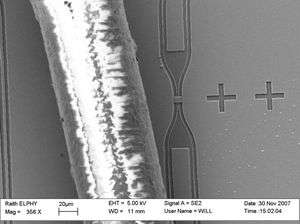Team develops tiny optical switch

A team of researchers at the University of St. Andrews has developed one of the smallest optical switches ever made.
The technology may eventually be used in small consumer devices that connect every home or office to an optical fibre and supply high data rates, including television on demand.
The researchers, based at the School of Physics and Astronomy and led by Professor Thomas Krauss, have used photonic crystal technology to reduce the size of the switch to only a few wavelengths of light. Consequently, the entire switch is only about one tenth of the size of a human hair.
Professor Krauss explained, "The switch is aimed at applications in telecommunications where we foresee its use in routing of optical signals.
"The idea of using fibre in the home or office requires small optical circuits that operate with low power. When these can be mass-produced in a cost-effective way it helps to keep the cost of the products down.
"At the moment, optical switches tend to be millimetres in size. It is difficult to state which is the smallest optical switch ever made - but this is certainly one of them."
By focussing on silicon as the material platform, the photonic devices developed by the group can be mass-produced in a similar way as computer chips for the microelectronics industry, and integrated with electronic circuitry on the same chip.
The group aims to address the increasing need for optical components at all levels of the communications network that carries the ever-increasing flow of data over the internet.
Source: University of St Andrews





















